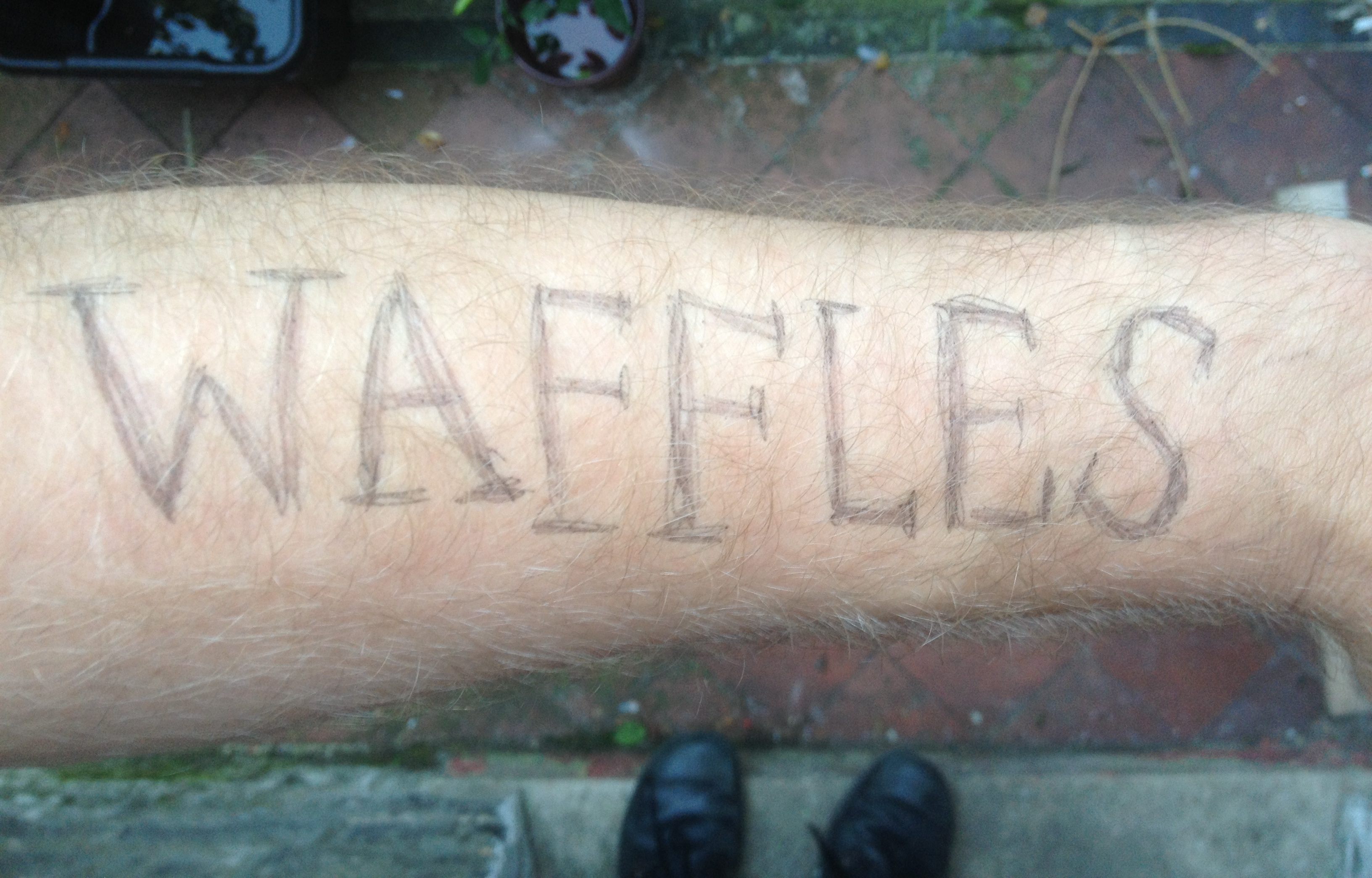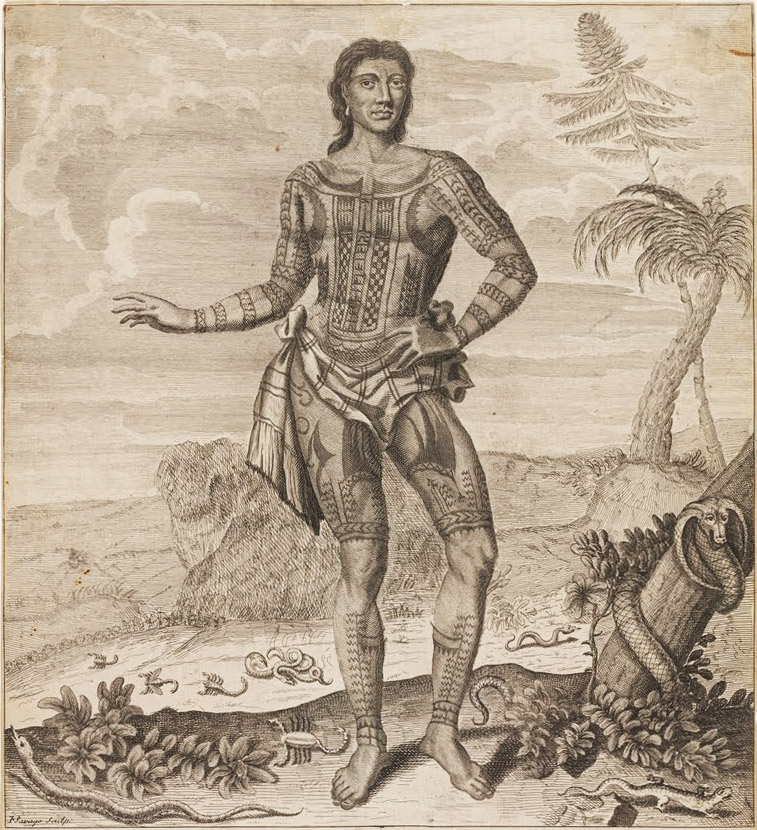 The skin is a supple and a slippery surface on which to write, so already impregnated and under-primed with various kinds of meaning that no word or phrase, when scored or inked on the skin, can be read simply. Cattle are branded, slaves and prisoners marked, warriors wounded both ritually and really, while the demographics of tattooing both abroad and at home predispose people to read the inked skin in particular ways – class, race, gender, and other categories are all at play, stressed and sometimes fractured. Last weekend’s (Ninth) International London Tattoo Convention (http://www.thelondontattooconvention.com/) put me in mind of tattooing again, and made me worry about the fact that I had written “WAFFLES” across my forearm in mad majuscules – not the “Que sais-je” of the post-modern Montaigne, alas, but a reminder to myself to season the irons before next Saturday breakfast, so that I don’t let down my daughter (again).
The skin is a supple and a slippery surface on which to write, so already impregnated and under-primed with various kinds of meaning that no word or phrase, when scored or inked on the skin, can be read simply. Cattle are branded, slaves and prisoners marked, warriors wounded both ritually and really, while the demographics of tattooing both abroad and at home predispose people to read the inked skin in particular ways – class, race, gender, and other categories are all at play, stressed and sometimes fractured. Last weekend’s (Ninth) International London Tattoo Convention (http://www.thelondontattooconvention.com/) put me in mind of tattooing again, and made me worry about the fact that I had written “WAFFLES” across my forearm in mad majuscules – not the “Que sais-je” of the post-modern Montaigne, alas, but a reminder to myself to season the irons before next Saturday breakfast, so that I don’t let down my daughter (again).
The tattoo convention also reminded me of the two inked skincases in Herman Melville’s Moby Dick – Queequeg’s metaphysical mapping, and Ishmael’s mnemonic self-writing. Of Queequeg’s illustrated skin Melville tells us a great deal, but nothing of all that description gets us any closer to an understanding of Queequeg himself, or of the “heavens and the earth” of which he is the microcosm:
[T]his tattooing had been the work of a departed prophet and seer of his island, who, by those hieroglyphic marks, had written out on his body a complete theory of the heavens and the earth, and a mystical treatise on the art of attaining truth; so that Queequeg in his own proper person was a riddle to unfold; a wondrous work in one volume; but whose mysteries not even himself could read, though his own live heart beat against them; and these mysteries were therefore destined in the end to moulder away with the living parchment whereon they were inscribed, and so be unsolved to the last.
The tattooing on Queequeg’s skin, the liminal surface between his beating heart and the world, draws attention to the incommensurability of the man and his universe, the strangeness of the human figure in its wide and inhuman seascape. The skin here is a material witness of the unintelligibility of the world to the human observer, but also of the human observer to the world. By contrast, Ishmael uses at least part of his body as a surface for recording observations about this world, here the dimensions of a whale:
The skeleton dimensions I shall now proceed to set down are copied verbatim from my right arm, where I had them tattooed; as in my wild wanderings at that period, there was no other secure way of preserving such valuable statistics. But as I was crowded for space, and wished the other parts of my body to remain a blank page for a poem I was then composing—at least, what untattooed parts might remain—I did not trouble myself with the odd inches; nor, indeed, should inches at all enter into a congenial admeasurement of the whale.
The literature with which Ishmael crowds the surface of his body lies cheek by jowl with “valuable statistics”; here, on the surface of his body, the world can be measured, and represented. What other fantastical figurations might cover the tattooed parts, we never learn, but certainly his skin appears (unlike Queequeg’s) a legible parchment. In both cases, though, Melville draws attention to the skin of the human body as a site for literary writing, as the place for “a wondrous work in one volume”, or the material on which one might compose a poem. Certainly the two men provide different versions of what Moby Dick, as a novel, itself is – a collection of facts and figures, of methods and dimensions, a narrative, a history, but also a poem of the world and its making, its flourishing and its destruction, a sort of occult chronicle of all things. In that sense, the two men’s skins provide by analogy two models for the novel. But in his tattoos Melville seems also to draw us right down from the grand literary project to the human basis, and the leaves fanning beneath our fingers become momentarily the case of a whale, the skin of a whaler. The skin might be a version of the novel; or the novel might be skin.

“Prince Giolo”, a tattooed Pacific Islander famously purchased, returned to England, and displayed in 1691. According to Thomas Hyde’s account of Giolo’s life (An account of the famous Prince Giolo, pub. 1592), the tattoos on Giolo’s back were even more impressive, and Queequeggian: “the more admirable back parts afford us a lively Representation of one quarter part of the World upon and betwixt his shoulders, where the Arctic and Tropick Circles meet in the North Pole upon his Neck.”
Of course books used to be bound in skins of various kinds, and it’s not much of a leap to start musing on the material dependence of our culture (including our literature) on the oil extracted from whales. It comes as no surprise when Melville classes his cetacean quarry in its various sizes and bulks, from duodecimo to folio. Michaelangelo stands in a sewer, eating a leg of lamb. But writing on the body brings very immediately to the attention the various ideological, economic, emotional, and even ontological operations at work in verbal representations of all kinds, and the way in which those representations constrain and limit, authorize and empower, connect and divide us. The mother who has tattooed a portrait of her child on her chest, or the child’s name on her shoulder, remembers the child, but also owns and assimilates it. The muscled masculine arm festooned with flowers can tolerate the perfume and sensuous colour of their blooms. The full embrace of a torso entablatured at once celebrates and denigrates the body, adorning it and effacing it, re-conceptualizing and re-equipping it as a surface rather than a solid of penetrable stuff. Paper is close to parchment, and parchment is skin; the activities of writing and reading always memorialize this corporeality, even if you aren’t working on Melville, or Plath, or Gilbert Godfrey. Every time we write and read, we cross that oceanic gap between the heavens and the earth, between the sea and sky, the gap that sounds us from guggle to zatch. Tattoos mind that gap; what do CPUs do?